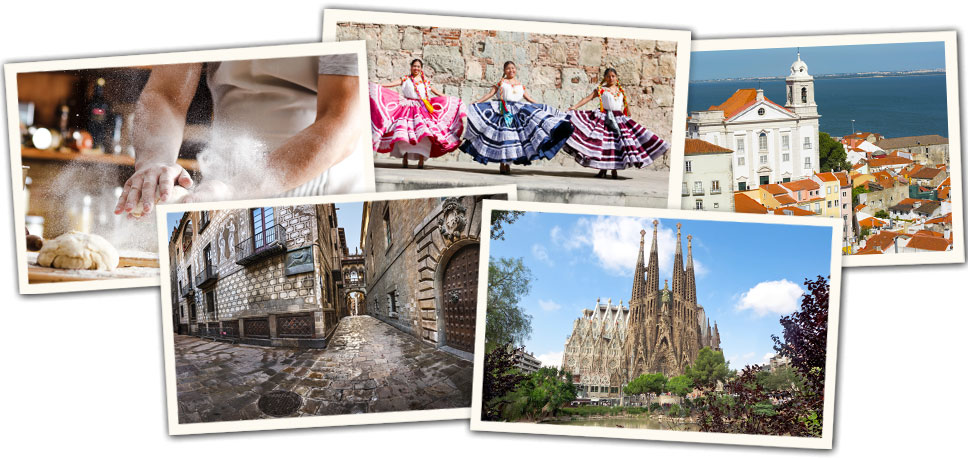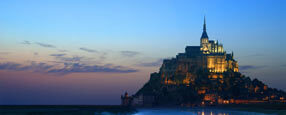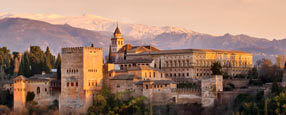SPAIN TOUR with York College
Depart BWI on 28 Feb
Cost from: 3870 USD *
Single Supplement: 500 USD
* Flights to/from BWI (Baltimore) to Barcelona
ITINERARY IN BRIEF
Today we arrive in Barcelona; transfer to our hotel. Rest of the day at leisure.
Tonight we will have a welcome dinner with a performance of the most famous and typical dance in Spain: Flamenco!
Flamenco is a style of music and dance which is considered part of the culture of Spain, although it is actually native to only one region: Andalusia. Andalusian, Gypsy, Sephardic, Moorish, and Byzantine influences have been detected in flamenco, often claimed to have coalesced around the time of the Reconquista in the 15th century. The origins of the term are unclear; the word flamenco itself was not recorded until the 18th century. Flamenco is the music of the Andalusian gypsies and played in their social community. Andalusian people who grew up around gypsies were also accepted as "flamencos".
Overnight in Barcelona.
Included meals: Dinner, if required.
Barcelona, the capital of Catalonia, is a cosmopolitan Mediterranean city that incorporates in its urban street pattern Roman remains, medieval districts and the most beautiful examples of Modernism and 20th century avant-garde art and emblematic buildings of Catalan architects Antoni Gaudí and Luis Doménech i Montaner declared to be World Heritage Sites by UNESCO.
Of Roman origin, Barcelona's long history and economic dynamism have provided it with an impressive cultural heritage, shown in the conservation of its rich historic and artistic heritage and in the encouragement of the newest artistic trends. Its long cultural agenda will lead the visitor through museums, exhibitions, outdoor sculptures, and an extensive calendar of music, theatre, and dance.
In the morning we'll visit Park Güell: Park Güell is like something out of a fairytale. It's a strange place, peculiar, even dreamlike, certainly beautiful. A walk through this park awakens even the least active imagination; the weird shapes and daring colour combinations, mingling with the plants, create a different world that visitors find irresistibly attractive. The architect's passion for natural shapes can be seen in every area. Gaudí wanted human creation in these woods to become an integral part of the landscape and complement it. Snails, mushrooms, leaves, tree-trunks, and elephants are constant leitmotifs in the mosaics and architectural shapes. Even the chimney-top on the caretaker's house has an inverted mushroom shape.
Around midday we'll see how Catalonian common people dance in front of the cathedral a typical Catalonian dance, La Sardana, a musical genre typical of Catalan culture and danced in circle following a set of steps. The dance was originally from the Empordà region but started gaining popularity throughout Catalonia from late 19th century to beginning of the 20th century after the modernization done by Josep Maria Ventura i Casas.
The steps are meticulously counted as two- or three-step movements taken sideways within the circle. The direction of the steps is alternated. The hands stay on the hip or shoulder level depending on the step structure. The pattern of the choreography has jumping intervals changing with the music. Usually there is more than one circle with varying tempo and levels of dance knowledge (Note: as this is not a 'show' per se, there is a slight possibility they will not be performing on the day of our visit).
Later we visit the 'must see' monument in Barcelona: The Sagrada Familia: Discover an unparalleled architectural gem, a unique creation that has become Barcelona's most universal symbol. This is the pinnacle of Antoni Gaudi's creation, a monumental church comprised of shapes, towers, curves and complex, unique sculptures. It is Barcelona's most visited building, a symbol of the Catalonian capital and the finest work of modernist architect Antoni Gaudí. The Sagrada Familia is architecturally complex and full of religious symbolism.
The great genius dedicated more than 40 years to the church, and, after his death in 1926, the project continued according to his original plans and drawings. Stone, brick, tile and glass come together in unimaginable (and technically difficult) architectural designs. Religious sculptures, immense stained-glass windows, and a host of decorative elements are fundamental to the work. Standing out overall are its impressive towers, more than 100 metres high. They force you to look upwards in order to take in this massive church, which, once completed, will have 18 towers, its highest reaching 170 metres.
Tapas Night Tour: This evening we have a guided tapas tour, during which we will be able to taste some of the most interesting tapas of Spain. Tapas is the name of a wide variety of appetizers or snacks in Spanish cuisine; they may be cold (such as mixed olives and cheese) or warm (such as chopitos, fried baby squid). In select bars in Spain, tapas has evolved into an entire, and sometimes sophisticated, cuisine. In Spain, patrons of tapas can order many different types and combine them to make a full meal.
Overnight in Barcelona.
Included meals: Breakfast and dinner
Spanish Cooking Class & La Boquería Market
Today we'll enjoy a La Boquería market tour a cooking class. Together, the tour and the class take approximately four hours. The tour starts with accompanying our chefs to the world famous La Boquería market, located nearby. During this 'behind the scenes' guided tour, you will meet many vendors, some of whom have been there for generations. You will learn about locally-grown products and participate in the selection of ingredients that will be used later in the cooking class.
Upon returning to our kitchen, you will begin preparing the four course menu consisting of classic paella, starter soup, appetizer, and dessert. The class provides a fun, social, hands-on experience, where you will be participating in the preparation of the various dishes under the guidance of our chef instructors.
Afternoon free in Barcelona
Overnight in Barcelona.
Included meals: Breakfast and lunch
Today we'll drive north to visit a Street Market in operation since the 9th century!
Vic, the capital of the region of Osona, is located on the banks of the Meder River in the vicinity of the impressive Sau reservoir. A Neoclassical cathedral dominates its secluded historic quarter, filled with attractions. A stroll around Vic will also lead us to emblematic landmarks, such as the episcopal palace Palau Episcopal, erected next to the cathedral precinct; the arcaded main square, or Plaza Mayor; the Roman temple; the convent of Sant Domènech, and the church of La Pietat.
The Mercadal (Market Square) or Plaça Major, is one of the best known and most dynamic sites in the city. This is where the weekly market is held every Tuesday and Saturday. The market has been held here since the 9th century, long before the first houses that frame the present-day square started to be built. Today you can still find stalls selling local produce, flowers, crafts and poultry, along with others selling clothes and accessories.
Here we can find a typical sausage which we'll learn to prepare.
VIC SALCHICHÓN SAUSAGE:
The quality of the best lean pork, careful manufacture and the climatic conditions of the Barcelona county of La Plana de Vic, which hugely influences its curing, give the Vic salchichón sausage its unmistakable aroma and flavour. To make it, meat and bacon from top-quality white pigs is used together with white and black pepper and salt, all macerated for at least 48 hours and packed in natural skins. The nearby Montseny Mountains, which generate a gentle but continuous breeze frequent mist, influence the curing of the pieces for 45 days, during which they acquire the sensory qualities that have made them so highly prized. The mixture is perfectly bound together and is very aromatic and tasty.
After this visit and experience, we'll head to Girona, where we'll have a short tour.
One of the most interesting in Catalonia, the historic city of Girona invites visitors to trace its more than 2,000 years of history through two fortified enclosures, the Força Vella and the Medieval Quarter. The Força Vella dates back to the Roman foundation, while the medieval extension of the city walls was carried out during the 14th and 15th centuries. The city's artistic heritage has been preserved in the numerous monuments that have survived until today. The highlights of Girona are rounded off by the impressive old Jewish Quarter or Call, with its beautiful streets and porticoed squares, and by the exuberant Baroque spaces and Noucentisme-style buildings by architect Rafael Masó.
Overnight in Girona.
Included meals: Breakfast
Departure to the north of Girona Province.
We want you to know first-hand the world of sheep, how they work on the farm, and how organic dairy products are made. We offer a different day, where you can touch small lambs, feed them with a bottle, and make your own curd. The visit of the facilities also includes a tasting of cheeses and custards.
After this experience, we will visit Figueres. Figueres, county capital of Alt Empordà, extends over a river plain situated inland in the province of Girona. Known as the home of Salvador Dalí, this town with deep Catalan roots offers visitors the chance to go to the Dalí Theatre-Museum, dedicated to the genius of surrealist painting. It is a cultural range completed with various museums and a calendar full of festivals and events divided up throughout the year.
Figueres also has an important heritage of monuments, among which the old medieval walls and the castle of Sant Ferran are outstanding, as well as examples of Modernist and Neoclassical architecture which appear dotted around the city centre, bound by remains of its old wall put up in the Middle Ages to defend the town. Beautiful corners from the medieval period are preserved, like the Plaza del Ayuntamiento, remodelled in Neoclassical style and where the council building stands, or the area around Carrer Magre, where there old Jewish quarter was located. La Rambla is the main place for walking and the real heart of the city.
The Dalí Theatre-Museum:
Without doubt, however, one of the historical milestones that has left the greatest mark on the character of the town was the birth of Salvador Dalí. The Dalí Theatre-Museum, situated in the old municipal theatre, has become one of the main cultural places to see in the city. Designed by the artist himself, it holds an important exhibition, which, through numerous works, allows you to take a trip through the career of the main considered a master of Surrealism. The site was extended with the Torre Galatea, where the artistic genius died.
Another two museums complete Figueres' wide cultural offer: the Catalan Toy Museum, which exhibits an interesting collection of toys from different periods and the Empordà Museum.
Overnight in Girona.
Included meals: Breakfast
Departure to Ventalló.
Ventalló, located in the heart of Empordà next to the ancient Greco-Roman city of Empúries and surrounded by centuries-old olive trees, has a long tradition in producing quality olive oil.
Oli de Ventalló, continuing the Serra Sala family's olive oil making tradition, produces the full-bodied and aromatic Anna Sala Trull de Ventalló extra virgin olive oil, the result of know-how handed down from generation to generation, and Serraferran extra virgin olive oil, an elegant, fresh oil with a balanced fruity flavour and the DOP Emporda's characteristic blend of tradition and modernity.
We can experience the world of olives and olive oil by strolling through olive groves and visiting the old hydraulic mill press and the estate's modern update, located at Mas Ferran, and learn to appreciate the quality of olive oil through tastings.
After this experience we'll visit the Bay of Roses:
The towns of Roses, Castelló d'Empuries and L'Escala are laid out almost in a line along the same bay on the coast of Ampurias, in the province of Girona. All together they form a curious arch-shaped route containing a wealth of natural resources. Visitors can catch a glimpse of an ancient past which does not turn its back on the future. Here boats, diving suits, and small planes allow one to discover the heart of an enclave which is inextricably tied to the blue Mediterranean. Beaches and coves, nature reserves and mountains, fascinating prehistoric monuments and ruins left by ancient settlers along this Mediterranean coast, museums, exceptional cuisine and an infrastructure for leisure and active tourism are among its many attractions.
This part of the Costa Brava also contains natural spaces such as Aiguamolls de l'Empordà, with a large number of native species of flora and fauna; the Cap de Creus, in the northern part of the Costa Brava; and the La Albera Mountains, with an interesting collection of megalithic monuments.
These monuments serve as a starting point for a historic journey along the bay. In the town of L'Escala we find other nearby ruins, those of the ancient Greek and Roman city of Ampurias, one of the most important archaeological sites on the peninsula. Equally outstanding is the Ciutadella de Roses, where you will find the ruins of the city of Rodhes (776 BC); the 11th-century monastery of Santa María, and
Renaissance fortifications; the 7th-century Visigothic Castrum and Trinidad Castle, dating from the 16th century. For its part, the town of Castelló d'Empuries has retained its cathedral, Jewish quarter, the city walls and convents, centres where documents chronicling the history of the bay have been preserved.
Return to Girona. Overnight in Girona.
Included meals: Breakfast
We can't fully understand Catalonian gastronomy without the Mediterranean Sea, so today we'll visit the Costa Brava. Before that though we'll spend the morning in a local farm and learn about the life of Spanish cows. We'll visit an exhibition hall of old tools, where you will see how technology changed the way of work for a lot of people: bakers, carpenters, gardeners, coal and tools that were used in labour camps until arrival of the first tractors. Lunch included in the farm.
We'll continue to the southern Costa Brava, visiting small fishermen villages, to finish in Palamós. We'll attend the auction of the fish. In the fishing interpretation center, a local guide will explain how it operates, the characteristics of the fleet, the sold species, the role of the buyers.
The Espai del Peix kitchen workshops are training sessions of seafood cuisine with the aim of enhancing the gastronomy of seafood that is marketed in the Palamós market, especially those that are more unknown to consumers or few of them listed on markets.
Return to Girona.
Overnight in Girona.
Included meals: Breakfast and lunch
Departure to Tarragona.
Our last thematic visit... Vineyards Clos Figueras:
Clos Figueras has a spectacular vineyard, with the classic 'llicorella' soil, just to the north of the famed town of Gratallops overlooking the Montsant River Valley. The original vineyard included a small plot of old Carignanand Grenache vines. This was completed in 1998 with plantings of more Grenache, Syrah, and a small amount of Cabernet Sauvignon, Mourvedre, and Viognier. With the new acquisition in 2000 came 2,500 old Grenache and Carignan vines, more than 60 years old. More vines were planted in 2001 including some Grenache Blanc, Chenin Blanc, and Touriga Nacional.
We propose a visit to our bodega at Clos Figueras and the opportunity to learn about the Priorat wines and how they are made.
We continue to Tarragona:
Tarragona, capital of Hispania Citerior during the Roman Empire, preserves many buildings from this period. The walls surrounding the historic centre were built in the 3rd century BC, although they were altered in the medieval period. Beside the sea stand the terraces of the Roman amphitheatre which, in its day, (2nd C), had capacity for more than 12,000 people. Here they attended combats between gladiators and wild animals. The former Tarraco also had a theatre and a circus. The theatre, outside the walled enclosure and nowadays on the Archaeological Walk, took advantage of the difference in levels in this area to built the terracing. Around the Plaça de la Font are preserved the vaults that supported the cavea (terracing) of the circus, an area where chariot races were held.
The historic centre of the city unfolds between the Mediterranean Sea and the old walls. In this area is the Cathedral of Santa María, a building constructed on the site of a Roman temple dedicated to Jupiter and a Muslim mosque. Romanesque doorways, Gothic roof arches and cloisters of Romanesque origin show the transition from one style to another. Also belonging to the Middle Ages are the arcades of the Calle Mercería, although the Calle de Çavallers is considered the main street of medieval Tarragona.
Continue to Barcelona, where we'll have our farewell dinner at Restaurant Font de Prade, specializing in Catalonia cuisine.
Overnight in Barcelona.
Included meals: Breakfast and dinner
Departure transfer to the airport. BUEN VIAJE!
Included meals: Breakfast
INCLUSIONS
- Accommodation in 3 star hotels on a triple or twin share
- Sightseeing and entrance fees as per itinerary
- Transportation in a private coach
- Local guides
- Breakfast daily
- Lunches and dinners as per the itinerary
- Air from BWI to Barcelona return
EXCLUSIONS
- Items of a personal nature
- Travel insurance
- Gratuities to local guides and driver
TOUR SAFETY
Global Educational Travel has implemented new safety measures and has received the World Travel and Tourism Council's Safe Travels stamp, which provides travellers with the assurance that we have adopted health and hygiene global standardised protocols – so you can experience 'Safe Travels'.
Click here for more info
LOOKING FOR INSPIRATION?








